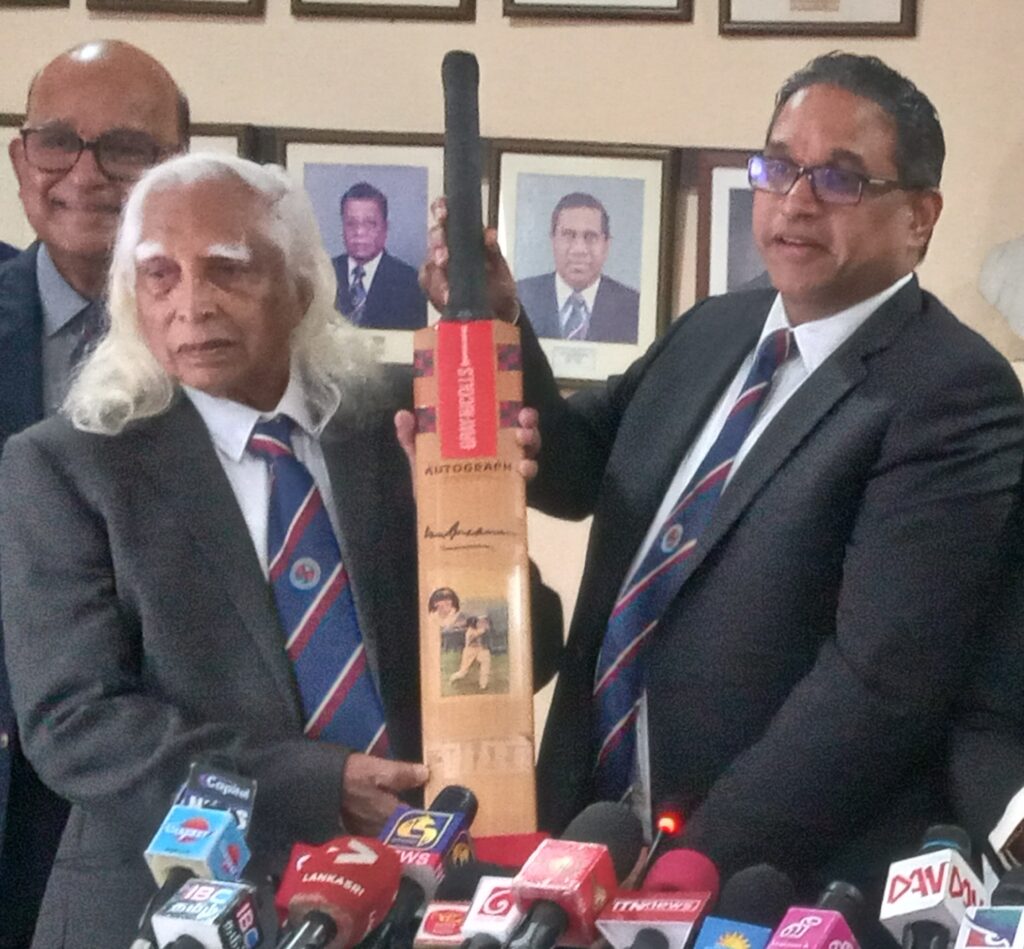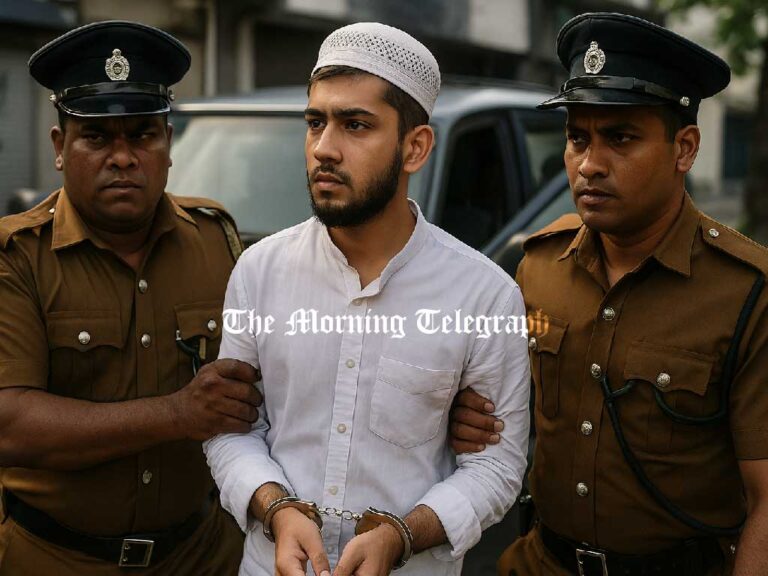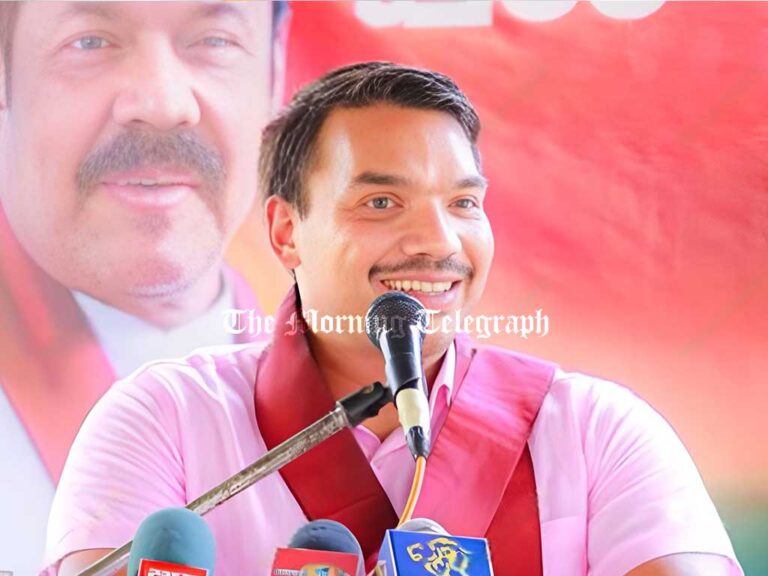
Ramesh Schaffter officially presents his father and Club pioneer Chandra Schaffter with a bat signed by Sir Donald Bradman
By Callistus Davy
It was July 1983 the hottest time of the year and the iconic Tamil Union Cricket and Athletic Club that administererd a famous ground called the Oval in downtown Colombo and hosted the country’s maiden Test match a year before was set to go up in flames, caught up in what was branded the worst form of communal brutality in the island’s history.
Armed with poles, axes, knives and burning torches scores of nearby shanty town dwellers stormed in screaming every obscenity in the book of rowdies leaving a trail of destruction that some members of the clubhouse saw as irredeemable to the point of no return.
The arsonists that also included women were no strangers to the Club and often took shelter from raging flood waters annually when it opened its doors to them for sanctuary and solace.
On a biblical scale the Club was burnt to the ground by the very peple who sought refuge and succour in it.
Having resurrected from the ashes, Tamil Union Cricket and Athletic Club is now set for a series of sports events to celebrate 125 years of service to the nation, but will make no secret of the madness the club was subjected to.
One eyewitness to the mayhem and destruction is now the grand old dad and Rock Star figure of the Club, Chandra Schaffter, who at age 95 is as energetic as anyone decades younger to him.
“We were totally destroyed and all our offices and records were burnt. The damage was so serious that we wanted to close down the club.”
“Some members even said we have no place in this country and others pleaded let’s ‘rebuild’,” Schaffter said at a Press conference while welcoming journalists in launching the Club’s anniversary celebrations.
The Tamil Union Cricket and Athletic Club, the only one of its kind in the country where the world’s cricket greats like Australian legend Donald Bradman and West Indies bowling icon Wesley Hall set foot, had asked for nothing other than wanting to exist while preserving its rich legacy and heritage for generations to come and playing its part in nation building.
Even after forgiving and moving on, the Club had to contend with outside politics, especially at the hands of the keepers of cricket in the cuntry who deliberately avoided allowing it to host international matches or tantalised them by shifting matches at the final hour on the grounds of security in some of the worst acts of injuctice and discrimination during the Civil War.
Sportsmanship took a back seat as other venues in Colombo and the provinces received preferential treatment that had much to do with egoism as Sri Lanka Cricket saw them as unwanted to host internatinal matches, a far cry from the days of the first England Test.
But with nothing to suppress them collectively, the Club found a way out of the madness as they rose from the tragedy and are now hoping for better days ahead.
“Tamil Union Cricket and Athletic Club was descriminated against during the LTTE war and did not receive any regular matches. We got a raw deal for being the first club in the country to have a stadium like this that promotes Sri Lanka cricket”, said Schaffter who is now the oldest living member of the club having enrolled in 1948 as a schoolboy from S. Thomas’ College.
Today in a bygone era the Tamil Union Cricket and Athletic Club, which nurtured the world’s best bowler in Muttiah Muralidaran from a raw 18-year old, is keen on moving on, while treasuring its pride and historic values.
“You cannot erase history anywhere in the world and we want to once again be back as the home of cricket in the country”, said the Club’s deputy president Rajan Saravanamuttu.
Through the Media they appealed that the government, Sports Ministry and Sri Lanka Cricket form an alliance with the Club to take it into the future, where the five-day version called Test cricket may have very little chance of surviving against the present scenario of youth entertainment and T20 showbiz cricket.
Already the Club has become a centre for the promotion of women’s cricket in the country and wants to play the lead role in becoming the best place for village boys and girls to learn the basics with several past players signalling a willingness to intervene as coaches.
Increasing its present seating capacity from 6000 to18,000 with an eye to the future is also high on the list.
“Every other club in Colombo has an English opulance around them and we too want everyone in the surrounding environs of Wanathamulla to benefit from cricket through internatinal matches and make sure the Oval returns to its branded image in the world”, said Saravanamuttu.
The fact that the P. Sara Oval with its reputation for having the fairest surface for both bat and ball has been sidelined for no fault of its own and has been a bitter pill to swallow for many.
A glympse into the Club’s pavilion and portraits of past cricketing greats and stalwarts remind visitors of its hallowed past, a past that no amount of discrimination can damn.
“We play according to the rules and uphold the highest standards of fairplay and sportsmanship and there is no match-fixing in our club”, declared the Club’s current president Ramesh Schaffter, who officially presented his illustrious father Chandra Schaffter with a bat signed by Donald Bradman when he played at the Oval with the Australian Invincibles in 1948.




